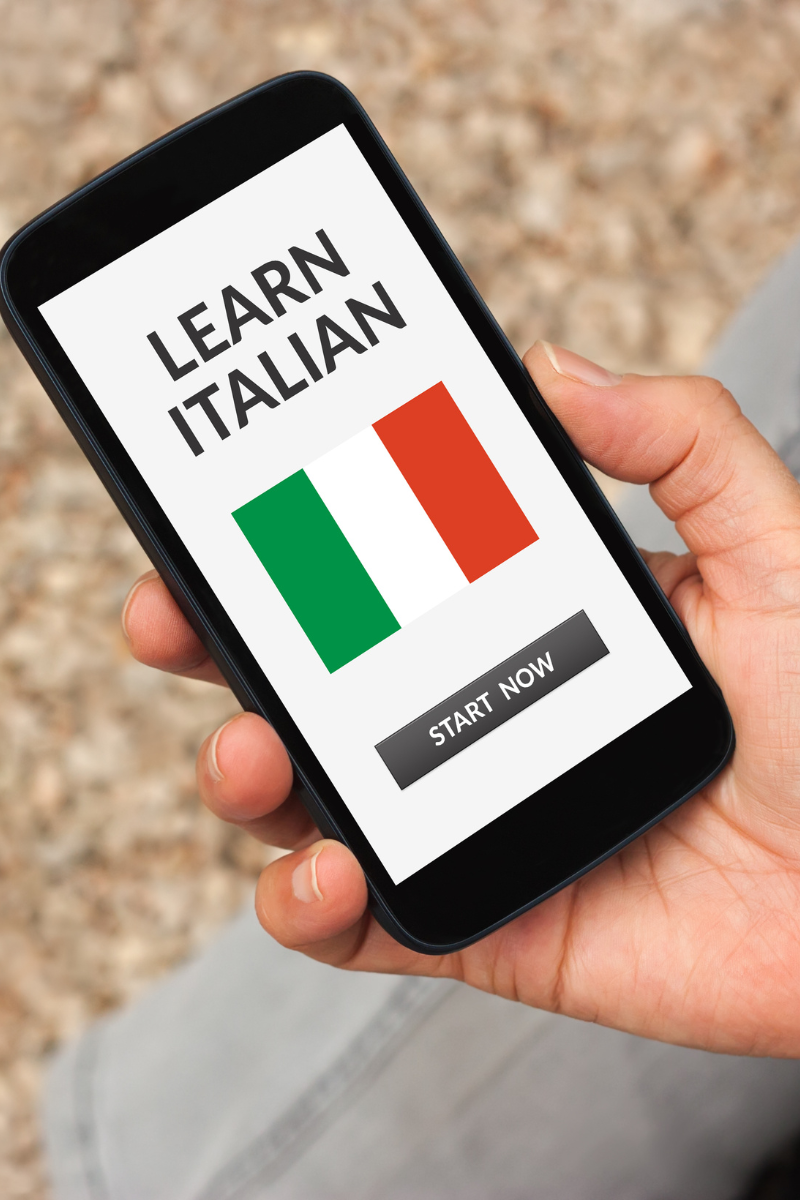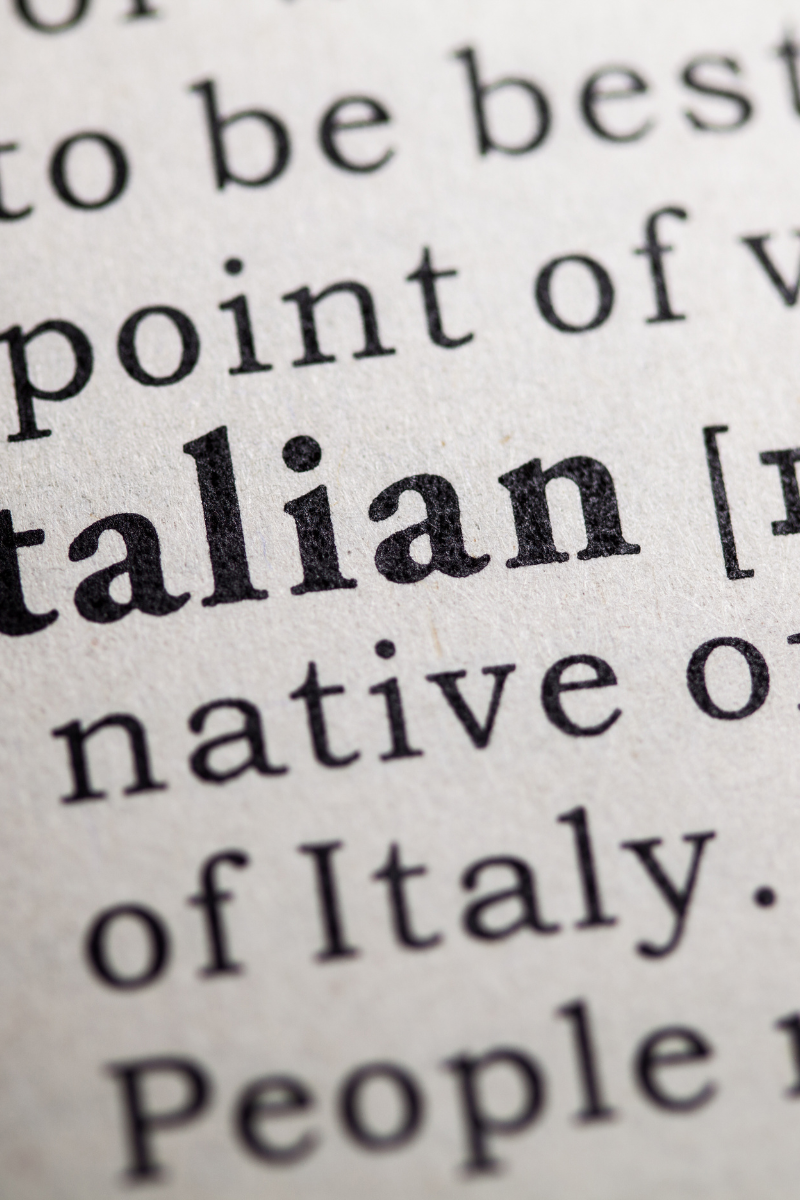Italian language learning: How can you master the beautiful Italian language in 2025? Here we walk you through the main aspects of the Italian language and what you have to consider when studying it.
Learning Italian language, as well as learning a new language in general, is an adventure that opens doors to a new culture, perspective, and connections. In this article, we’ll delve into the captivating world of Italian language learning. We’ll explore its unique charm, challenges, and the joy of unlocking a new linguistic landscape.
1. Embrace the melody of the Italian language
Italian, often described as the language of love, has a melodic and expressive quality that captivates learners like yourself.
Here are the main aspects of the Italian language that make it so appealing. Keep them in mind while studying its phonetics:
- Innate musicality: The Italian language is renowned for its intrinsic musicality, characterized by a melodic rhythm that makes it pleasant to hear.
- Pure vowels: Italian has five pure vowels: a, e, i, o, and u. They are pronounced clearly, contributing to the harmonious sonority of the Italian language.
- Open syllables: Italian words often end in vowels, creating open syllables that contribute to the melodic flow of the language.
- Syllabic stress: In Italian, syllabic stress generally falls on the penultimate syllable of a word, giving a rhythmic cadence to the pronunciation.
- Expressive intonation: Italians tend to use expressive intonation, with variations in tone that add emotional nuances to communication.

- Lexical richness: The Italian language is rich in words and phrases that sound like a melody. This is due to the harmonious combination of consonant and vowel sounds.
- Musical tradition: The musical heritage of Italy, including genres such as opera and classical music, has influenced the musicality of the language, making it intrinsically linked to the country’s musical culture.
- Accompanying gestures: Italians use gestures and facial expressions extensively during communication, which integrate harmoniously with the melody of the language.
- Poetry and prose: Italian literature, both in poetic and prose form, reflects the musicality of the language. This is achieved in particular through the careful choice of words and their rhythmic arrangement.
- Regional variety: While maintaining a common melodic base, Italian presents regional variations in pronunciation and intonation which further enrich its musicality.
Don’t be afraid to dive into the beauty of Italian pronunciation and discover the musicality that sets it apart! 🎵
2. Get familiar with the Italian culture
You should know that language is intertwined with culture, and Italian is no exception.
Here is the list of what makes Italian culture what it is, and what YOU should look into if you want to have a good understanding of Italian:
- Rich literary history: The Italian language has a rich and varied literary history. That includes works by famous authors such as Dante Alighieri, Giovanni Boccaccio, Francesco Petrarca, Alessandro Manzoni, and many others.
- Artistic culture: Italy is famous for its rich artistic tradition which includes masterpieces of Renaissance, Baroque, and contemporary art. They contributed to the enrichment of the Italian language through cultural expressions.
- Refined cuisine: Italian cuisine is renowned throughout the world for its variety, authenticity, and refined taste, with iconic dishes such as pizza, pasta, and ice cream, reflecting Italian rich gastronomic culture.
- Traditions and festivities: Italy is rich in cultural traditions and regional holidays. Among these are the Venice Carnival, Palio of Siena, and religious celebrations such as Holy Week, which influence the language and enrich Italy’s cultural heritage.
- Architectural heritage: Italy boasts an extraordinary architectural heritage. Its iconic monuments such as the Colosseum, Milan Cathedral, and the Leaning Tower of Pisa, reflect the country’s rich history and culture.

- Folk traditions: In addition to official celebrations, Italy also has its folk traditions. They include popular festivals, traditional dances, and regional customs. They all enrich the culture and influence the use of the Italian language.
- Music and opera: Italy has a long musical tradition that ranges from classical music to opera, pop to jazz, with renowned artists such as Giuseppe Verdi, Luciano Pavarotti, and Andrea Bocelli. They helped define the Italian musical landscape.
- UNESCO World Heritage: Italy has numerous UNESCO World Heritage Sites, including historic cities, cultural landscapes, and works of art that reflect the country’s rich culture and history.
- Fashion and design: Italy is a major global center for fashion and design. With high fashion brands such as Gucci, Prada, and Versace and their creativity and innovation, Italy influences global trends and enriches Italian culture.
- Hospitality and outdoor living: Italian hospitality is renowned throughout the world. The culture of outdoor living encourages social gatherings, long lunches, and evenings spent with friends and family. This contributed to the liveliness and vitality of the language and Italian culture.
Explore the rich history, art, and literature that shape the Italian language, making each word a gateway to a cultural masterpiece! 🎭
3. Navigate Italian language pronunciation
From rolling R to mastering vowel sounds, pronunciation in Italian presents both challenges and triumphs.
Let’s take a look at what you need to consider when studying the Italian pronunciation:
- Vowel phonemes: Italian has five phonemic vowels: /a/, /e/, /i/, /o/, /u/. These vowels are distinct, making pronunciation clearer and more precise, which you will notice when embarking on the journey of learning Italian language.
- Consonant phonemes: Italian has many consonant phonemes, including some consonants that may be pronounced slightly differently than English. For example, “g” is pronounced as /g/ in front of “a”, “o”, “u”, and as /dʒ/ in front of “e” and “i”.
- Open and closed syllables: Italian words are often composed of open syllables (ending in a vowel) and closed syllables (ending in a consonant). This affects the rhythm and flow of the language, with a tendency to emphasize stressed syllables.
- Tonic accent: In Italian, the tonic accent falls on the penultimate syllable of the word, unless there are specific exceptions. This regular tonic pattern contributes to the melodic rhythm of the language.
- Vowel reduction: In some situations, unstressed vowels may be subject to reduction or even elision. This happens especially in truncated words or sequences of words. This phenomenon affects the fluidity and naturalness of pronunciation.

- Word ligature: In Italian, words tend to flow together without clear pauses between them. This binding of words is another factor that contributes to the fluidity and melodic rhythm of the language.
- Consonant assimilation: In certain situations, consonants may undergo assimilation or phonetic changes due to the presence of adjacent consonants. For example, the consonant “n” can assimilate to the following consonant, becoming “m” before labials such as “p” or “b”.
- Spelling transparency: In general, Italian spelling is more transparent than other languages, meaning that the pronunciation of words can be easily deduced from their spelling.
- Regional variations: As with many languages, Italian has regional variations in pronunciation. These variations can have subtle differences in rhythm, accent, and cadence between various regions of the country.
- Expression and intonation: In addition to the correct pronunciation of phonemes, expression and intonation play a fundamental role in effective communication in Italian, contributing to the understanding and communication of emotional and contextual meanings.
Uncover practical tips and tricks to navigate the intricacies of Italian phonetics! 🔊
4. Conquer Italian verb conjugations
Italian verb conjugations can be a formidable challenge for you.
Here you’ll find information about the characteristics of Italian verbs and their conjugations to help you when learning the Italian language:
- Verbal root: Every Italian verb has a verbal root. The verbal root constitutes the nucleus of the verb and determines its main form.
- Infinitive: The infinitive is the basic form of the verb in the dictionary. In Italian, it ends in “-are”, “-ere”, or “-ire”, depending on the verb group it belongs to.
- Three conjugations: Italian verbs are classified into three main conjugations based on the ending of the infinitive: first (-are), second (-ere), and third (-ire).
- Verb tenses and moods: Italian verbs can be conjugated in various verb tenses and moods, including present, present perfect, past simple, past perfect, imperfect, simple future, future perfect, present conditional, past conditional, present subjunctive, present perfect subjunctive, imperfect subjunctive, past perfect subjunctive, and imperative.
- Verbal moods: You can conjugate Italian verbs in various verbal moods, including indicative, subjunctive, conditional, and imperative.

- Regularity and irregularity: Many Italian verbs follow regular conjugation patterns, while others are irregular and follow different conjugation patterns.
- Past participles: Every Italian verb has a past participle, used mainly to form compound tenses, such as the present perfect.
- Gerunds: Gerunds are verbal forms used to express contemporary or ongoing actions. They are formed by adding the endings “-ando” (for the verbs of the first group), or “-endo” (for the verbs of the second and third group) to the verbal root.
- Regular conjugation: Regular verbs follow predictable conjugation patterns based on which one of the three main conjugations they belong to (-are, -ere, or -ire).
- Irregular conjugation: Irregular verbs have forms of conjugation that deviate from regular patterns. They often change the verb stem or endings in different tenses and moods.
You can use our content, materials, and resources to unravel the complexities, gain insights and strategies to conquer the important verb tenses. 📝
5. Immerse yourself in the Italian language learning
Immerse yourself in the Italian language learning through various resources, from authentic films and music to language exchange programs.
This is why you should learn Italian and some of the best ways to do it:
- Cultural richness: Learning the Italian language offers the opportunity to immerse yourself in a culture rich in history, art, music, food, and traditions.
- Romance language: Italian is a Romance language. It derives from Latin, and shares linguistic roots with other European languages such as French, Spanish, Romanian, and Portuguese.
- Melody and musicality: The Italian language is known for its melody and musicality. They make learning and using the language more pleasant and engaging.
- Regional variations: Italy is characterized by regional variations in language and accent, meaning that the Italian spoken in the north of the country is different from the Italian spoken in the south.
- Grammatical structure: Italian grammar presents clear and systematic rules for the conjugation of verbs, the formation of verb tenses, the concordance of nouns and adjectives, and the order of words in sentences.

- Wide availability of resources: There are many resources available for learning the Italian language. They include online courses, textbooks, tutors, private lessons, language learning apps, and instructional videos.
- Cultural immersion: Cultural immersion is an effective way of learning the Italian language. It means listening to Italian music, watching Italian films and TV series, reading Italian books and newspapers, and attending Italian cultural events.
- Constant practice: Constant practice is essential to improving your Italian language skills, which may include conversations with native speakers, writing exercises, listening to audio and video recordings, and active participation in language lessons.
- Online learning: With the advent of technology, there are numerous online platforms dedicated to Italian language learning. These platforms offer structured courses, interactive exercises, audiovisual resources, and support from expert tutors.
- Long-term benefits: Learning the Italian language not only allows you to communicate with millions of people around the world, but can also open doors to study, work, travel, and personal development opportunities in Italy and other parts of the world.
Discover how surrounding yourself with the language accelerates the learning process! 🎬
6. Use technological aids to learn the Italian language
Explore the digital realm of Italian language learning with apps, online courses, and language exchange platforms:
- Language learning apps: Applications like Duolingo, Babbel, Rosetta Stone, and Memrise offer fun, interactive courses for learning Italian. They do it through vocabulary, grammar, listening, and pronunciation exercises.
- Educational websites: Numerous educational websites dedicate their work to teaching the Italian language, such as ItalianPod101, FluentU, and ItaliaRail, which offer instructional videos, lessons, exercises, and additional resources for practicing the language.
- Online tutoring platforms: Platforms like iTalki, Verbling, and Preply connect you with native Italian tutors for private lessons via video call, allowing for personalized, interactive language practice.
- YouTube channels: Many YouTube channels offer free Italian lessons, grammar tutorials, pronunciation exercises, and real conversations in Italian to improve your language skills.
- Podcasts: Podcasts like Coffee Break Italian, Radio Arlecchino, and ItaliaMadeEasy provide audio content in Italian, ranging from language lessons to authentic conversations. These can help you improve your listening and understanding of the language.

- Language resource websites: Sites like WordReference, Treccani, and Reverso offer online dictionaries, grammar guides, discussion forums, and other useful language resources for students of Italian.
- Social media: Online groups and communities on social platforms such as Facebook, Reddit, and Discord offer you opportunities to interact with other Italian learners, exchange resources, and practice the language in an informal context.
- Educational games: Apps and websites like Quizlet, FluentKey, and Kahoot offer interactive games and quizzes to practice vocabulary, grammar, and other language skills in a fun and engaging way.
- Speech recognition tools: Apps like Speechling and HelloTalk allow you to practice pronunciation and improve conversation skills by interacting with speech recognition apps and receiving feedback from native speakers.
- eBooks and audiobooks: Platforms such as Amazon Kindle and Audible offer a vast selection of digital books and audiobooks in Italian. These resources allow students like yourself to read and listen to stories in Italian to improve linguistic comprehension and expression.
Embrace technology as your ally on the journey to mastering Italian! 💻
7. Build confidence in speaking Italian language
Building confidence in speaking is a crucial aspect of Italian language learning. Here are some ways for you to do this:
- Celebrate small successes: Every time you reach a goal or overcome a challenge, take time to celebrate your success. Even small achievements, like learning a new word or understanding a complicated sentence, deserve recognition.
- Be patient with yourself: Learning a new language takes time and dedication. Be kind and patient with yourself during the learning process, and remember that it’s normal to make mistakes along the way.
- Make mistakes and learn from them: Mistakes are part of the learning process and are an opportunity to grow. Don’t be afraid of making mistakes, but rather learn from mistakes and use them as an opportunity to improve.
- Maintain a positive mindset: Cultivate a positive mindset towards learning Italian language. Be optimistic about your abilities and focus on the progress you have made rather than the challenges you still face.
- Experiment and test yourself: Challenge yourself to use the Italian language in new contexts and situations. Talk to native speakers, write diaries or messages in Italian, listen to music, and watch Italian films. The more you expose yourself to the language, the more confident you will become in your language skills.

- Learn from others: Try to connect with other Italian students and share your learning experiences. Join study groups, online forums, or conversation classes to exchange advice, support, and motivation with each other.
- Keep a record of your progress: Track your progress by keeping a learning diary or achievement log. Track new vocabulary learned, phrases you’ve mastered, and goals you’ve achieved to visualize your improvement over time.
- Remember your why: Keep your reason for learning Italian alive. Whether it’s traveling to Italy, connecting with your cultural roots, or enhancing your career opportunities, constantly remember why you started this learning journey.
- Repeat positive affirmations: Practice self-empowerment by using positive affirmations about your language skills. Repeat phrases like “I am capable of learning Italian”, or “Every day I am getting better and better” to strengthen your self-esteem and motivation.
- Reward yourself: Reward yourself for your effort and success in learning Italian language. Plan rewards for your achievements, such as a small gift for yourself or a relaxing evening after an intense week of studying.
We’ll share practical exercises and activities to enhance your speaking skills, helping you communicate with assurance. 📚
8. Embrace mistakes while learning Italian language
Learning the Italian language is a journey filled with ups and downs. Here is a complete list of facts about mistakes you will have during the learning process:
- Natural part of the process: Mistakes are a natural and inevitable part of the process of learning a new language, including Italian. You should not see them as a defeat, but rather as an opportunity to learn and improve.
- Medium of learning: Mistakes are an important means of learning. Often, by making mistakes you are forced to reflect on your linguistic knowledge and to better understand the rules of the Italian language.
- Indicate areas of focus: Mistakes can indicate specific areas where you need to focus to improve. For example, if you frequently make verb conjugation errors while learning the Italian language, you may need to review the verb conjugation rules.
- Result of linguistic interference: Errors can be the result of linguistic interference, i.e. the influence of your native language on learning the Italian language. Recognizing and correcting these interferences is essential to improvement.
- Challenge self-esteem: Mistakes can be frustrating and challenge your self-esteem. It is important to remember that making mistakes is part of the learning process and does not reflect on your intelligence or ability.

- Different types of errors: Errors can be of different types, including grammatical errors, pronunciation errors, vocabulary errors, and comprehension errors. Identifying the type of error can help you better understand how to fix it.
- Crucial feedback: Receiving correct and constructive feedback on errors is essential for improvement. Ask teachers, tutors, or native speakers for help in spotting and correcting mistakes you make.
- Timely correction: You must correct errors promptly to prevent them from becoming bad linguistic habits. Try to correct mistakes as soon as you identify them and make an effort not to repeat them.
- Continuous learning: Errors in Italian language learning are an ever-evolving process. Even when you reach an advanced level, it’s normal to make occasional mistakes. The important thing is to learn from them and continue to improve.
- Sign of progress: Finally, mistakes are often a sign of progress. As you become more familiar with the Italian language, your mistakes are likely to become less frequent and you will become more confident in your language skills.
Embrace mistakes as stepping stones to proficiency and learn how to turn challenges into valuable lessons. ❌
8. Conclusion
Embarking on the journey of learning the Italian language is not just about mastering words. It’s about immersing yourself in a new world. From the appealing sound of the language to the triumphs over challenges, each step brings you closer to fluency.

So, let the adventure begin, and may your Italian language learning journey be as enriching as the culture it unveils.
Buon viaggio! ❤
This article was all about Italian language learning, what you should consider, and pay attention to in 2025 while studying this amazing Romance language.
Our recommendations

Dive into the vibrant world of Italian with Italian Short Stories for beginners! This engaging collection of 20 captivating short stories is designed to make learning Italian fun and accessible. Perfect for beginners, each tale introduces essential vocabulary and grammar in a natural, enjoyable way, helping you build confidence while immersing yourself in Italy’s rich culture. Start your language journey today with stories that entertain and educate!

Master Italian grammar with this comprehensive workbook, tailored for beginners, which offers clear explanations, practical exercises, and included audio to guide you through the essentials of Italian grammar. Perfect for building a strong foundation, it makes learning engaging and effective. Start speaking Italian confidently today!

Boost your Italian skills on the go with ItalianlLanguage flashcards! This set of 52 vibrant flashcards features over 275 essential words and phrases, complete with pronunciation guides, online audio, and charming illustrations. Perfect for students and travelers, these cards make learning Italian fun, fast, and effective. Start your language adventure today!

Practice Makes Perfect: Complete Italian All-in-One, Premium Second Edition
Get ready to master Italian with this user-friendly guide that combines grammar, vocabulary, and practical exercises into one comprehensive resource, perfect for beginners and intermediate learners alike. With clear explanations, engaging activities, and premium online resources, you’ll build confidence in speaking, reading, and writing Italian. Start your journey to fluency today!

Jump into this fun, user-friendly guide that makes learning Italian a breeze with quick, bite-sized lessons perfect for busy schedules. Packed with interactive exercises, flashcards, and practical phrases, it’s ideal for beginners eager to speak with confidence. Start your Italian adventure today—grab your copy and learn in just 10 minutes a day!


